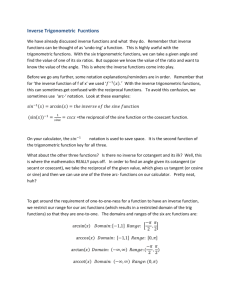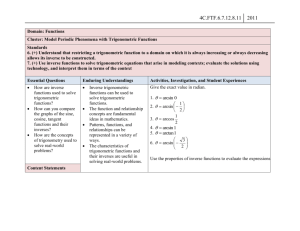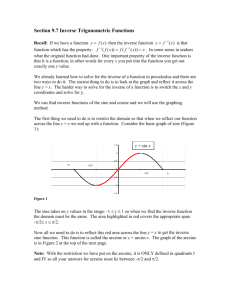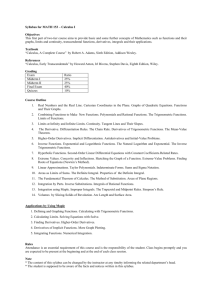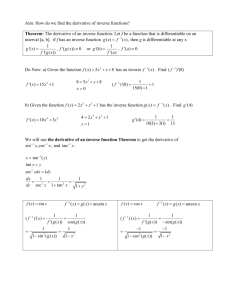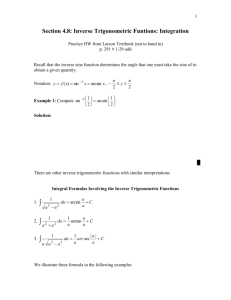Inverse trigonometric functions (Sect. 7.6) Review: Definitions and
advertisement
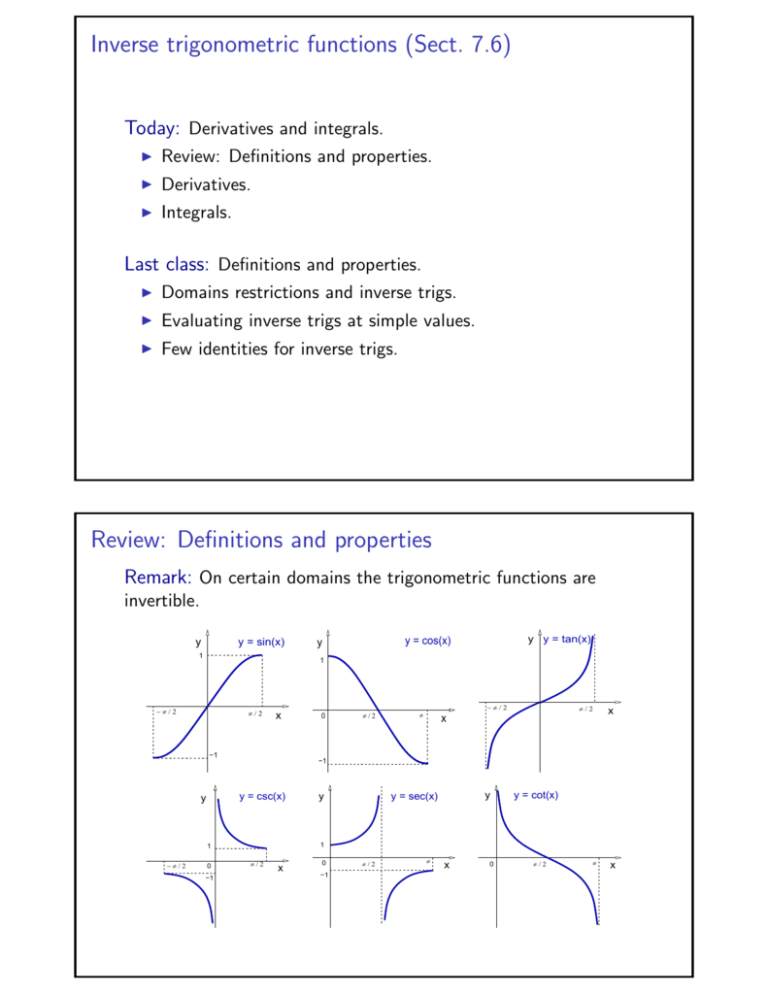
Inverse trigonometric functions (Sect. 7.6)
Today: Derivatives and integrals.
I
Review: Definitions and properties.
I
Derivatives.
I
Integrals.
Last class: Definitions and properties.
I
Domains restrictions and inverse trigs.
I
Evaluating inverse trigs at simple values.
I
Few identities for inverse trigs.
Review: Definitions and properties
Remark: On certain domains the trigonometric functions are
invertible.
y
y = sin(x)
1
1
−π/2
π/2
x
−1
0
π/2
−π/2
π
π/2
x
x
y
y
y = sec(x)
y = cot(x)
1
1
−1
0
−1
y = csc(x)
y
−π/2
y y = tan(x)
y = cos(x)
y
π/2
x
0
−1
π/2
π
x
0
π/2
π
x
Review: Definitions and properties
Remark: The graph of the inverse function is a reflection of the
original function graph about the y = x axis.
y
y = arcsin(x)
y
π/2
y
y = arccos(x)
π
−1
1
π/2
π/2
x
x
−π/2
−π/2
−1
y
0
1
y
y = arccsc(x)
π/2
−1
0
y = arctan(x)
x
y = arcsec(x)
y
π
1
x
y = arccot(x)
π
π/2
π/2
−π/2
−1
0
1
0
x
x
Review: Definitions and properties
Theorem
For all x ∈ [−1, 1] the following identities hold,
arccos(x) + arccos(−x) = π,
arccos(x) + arcsin(x) =
π
.
2
Proof:
y
y
arcsin(x)
arccos(−x)
1
1
x = sin(π/2−θ)
arccos(x)
θ
−x = cos (π−θ)
arccos(x)
π/2 − θ
π−θ
θ
θ
x = cos (θ)
x
x = cos (θ)
x
Review: Definitions and properties
Theorem
For all x ∈ [−1, 1] the following identities hold,
arcsin(−x) = − arcsin(x),
arctan(−x) = − arctan(x),
arccsc(−x) = −arccsc(x).
Proof:
y
y = arcsin(x)
π/2
−1
y = arctan(x)
x
x
−π/2
Inverse trigonometric functions (Sect. 7.6)
Today: Derivatives and integrals.
I
Review: Definitions and properties.
I
Derivatives.
I
Integrals.
y
y = arccsc(x)
π/2
π/2
1
−π/2
y
−1
0
1
−π/2
x
Derivatives of inverse trigonometric functions
Remark: Derivatives inverse functions can be computed with
0
f −1 (x) =
1
.
f 0 f −1 (x)
Theorem
The derivative of arcsin is given by arcsin0 (x) = √
1
.
1 − x2
Proof: For x ∈ [−1, 1] holds
1
1
=
cos arcsin(x)
sin0 arcsin(x)
hπ π i
For x ∈ [−1, 1] we get arcsin(x) = y ∈
, , and the cosine is
2q 2
positive in that interval, then cos(y ) = + 1 − sin2 (y ), hence
arcsin0 (x) =
1
arcsin0 (x) = q
1 − sin2
1
0
√
⇒
arcsin
(x)
=
.
2
1
−
x
arcsin(x)
Derivatives of inverse trigonometric functions
Theorem
The derivative of inverse trigonometric functions are:
1
1
,
arccos0 (x) = − √
,
|x| 6 1,
1 − x2
1 − x2
1
1
0
,
arccot
,
x ∈ R,
arctan0 (x) =
(x)
=
−
1 + x2
1 + x2
1
1
arcsec0 (x) = √
, arccsc0 (x) = − √
, |x| > 1.
|x| x 2 − 1
|x| x 2 − 1
arcsin0 (x) = √
1
cos2 (y ) + sin2 (y )
0
, tan (y ) =
Proof: arctan (x) =
cos2 (y )
tan0 arctan(x)
0
tan0 (y ) = 1 + tan2 (y ), y = arctan(x), ⇒ arctan0 (x) =
1
.
1 + x2
Derivatives of inverse trigonometric functions
Proof: arcsec0 (x) =
1
, for |x| > 1.
sec0 arcsec(x)
Then y = arcsec(x) satisfies y ∈ [0, π] − {π/2}. Recall,
1 0
sin(y )
sec (y ) =
,
=
cos(y )
cos2 (y )
0
q
sin(y ) = + 1 − cos2 (y ),
p
p
2 (y )
1 − cos2 (y )
1
−
cos
1
,
=
sec0 (y ) =
| cos(y )|
| cos(y )|
cos2 (y )
1
sec (y ) =
| cos(y )|
0
s
1
− 1 = | sec(y )|
cos2 (y )
We conclude: arcsec0 (x) =
q
sec2 (y ) − 1.
1
.
|x| x 2 − 1
√
Derivatives of inverse trigonometric functions
Example
Compute the derivative of y (x) = arcsec(3x + 7).
Solution: Recall the main formula: arcsec0 (u) =
Then, chain rule implies, y 0 (x) =
1
√
.
|u| u 2 − 1
3
p
.
|3x + 7| (3x + 7)2 − 1
C
Example
Compute the derivative of y (x) = arctan(4 ln(x)).
Solution: Recall the main formula: arctan0 (u) =
Therefore, chain rule implies,
1
4
y 0 (x) = 2 x
1 + 4 ln(x)
⇒
1
.
1 + u2
4
.
y0 = C
x 1 + 16 ln2 (x)
Inverse trigonometric functions (Sect. 7.6)
Today: Derivatives and integrals.
I
Review: Definitions and properties.
I
Derivatives.
I
Integrals.
Integrals of inverse trigonometric functions
Remark: The formulas for the derivatives of inverse trigonometric
functions imply the integration formulas.
Theorem
For any constant a 6= 0 holds,
Z
x dx
√
+ c,
|x| < a,
= arcsin
2 − x2
a
a
Z
x dx
1
= arctan
+ c,
x ∈ R,
a2 + x 2
a
a
Z
x dx
1
√
|x| > a > 0.
= arcsec + c,
a
a
x x 2 − a2
x Proof: (For arcsine only.) y (x) = arcsin
+ c, then
a
1
|a|
1
1
1
=√
⇒ y 0 (x) = √
y 0 (x) = q
2
a2 − x 2 a
a2 − x 2
1− x a
a2
Integrals of inverse trigonometric functions
Example
Z
6
Evaluate I =
p
3 − 4(x − 1)2
dx.
Solution: Substitute: u = 2(x − 1), then du = 2 dx,
Z
I =
Z
Recall:
6
du
√
=3
3 − u2 2
Z
√
du
.
3 − u2
u √
dx
√
= arcsin
+ c. Then, for a = 3,
a
a2 − u 2
u I = 3 arcsin √ + c
3
⇒
2(x − 1) √
I = 3 arcsin
+ c. C
3
Integrals of inverse trigonometric functions
Example
Z
6
2
dt.
t ln (t) + ln(t 4 ) + 8
Evaluate I =
Solution: Recall: ln(t 4 ) = 4 ln(t), Try to complete the square.
Z
6
2
dt,
I =
t ln (t) + 4 ln(t) + 8
Z
I =
6
2
dt
t ln (t) + 2(2 ln(t)) + 4 − 4 + 8
Z
I =
6
t ln(t) + 2
2
dt
+4
This looks like the derivative of the arctangent.
Integrals of inverse trigonometric functions
Example
Z
Evaluate I =
6
2
dt.
t ln (t) + ln(t 4 ) + 8
Z
Solution: Recall: I =
6
t ln(t) + 2
2
Substitute: u = ln(t) + 2, then du =
Z
I =
I = 3 arctan
6
du = 6
4 + u2
1
2
Z
(ln(t)+2) +c
dt.
+4
1
dt,
t
u du
1
= 6 arctan
+ c.
22 + u 2
2
2
⇒
√
I = 3 arctan ln( t)+1 +c.
C
